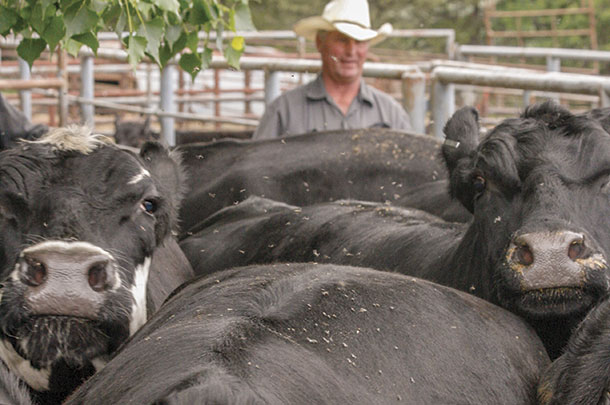For some livestock producers, fly season is not that far away. Producers in Southern states are already, or will soon be, dealing with their impact.Livestock producers in the Northern states can now review their current fly management plan to make improvements from last year if it did not work well. Three fly species that can economically impact pastured cattle are the horn fly, face fly and stable fly. Many different fly control options are available to livestock producers.
Horn fly
Horn flies are small – less than a quarter of an inch in size and are commonly found of the backs, sides and poll area of cattle. During warm weather, especially by midafternoon, they will often be found on the belly region of cattle where there is shade and cooler conditions. Male and female flies will acquire more than 30 blood meals per day..
Once the female has mated, she will leave the animal to deposit eggs in fresh cattle manure. During warm weather, the entire life cycle can be completed in 10 to 20 days. Newly emerged horn flies can travel several miles searching for a host. Fly immigration can result in an increase in fly populations even if good fly management practices are in place.
Horn fly feeding causes irritation, blood loss, decreased grazing efficacy, reduced weight gains and diminished milk production in mother cows. Additionally, horn flies can spread summer mastitis. Research conducted in the U.S. and Canada have shown horn flies can decrease weight gain in cattle and negatively impact calf weaning weights from 4 to 15 percent.
Trials in Nebraska have established calf weaning weights were 10 to 20 pounds higher when horn flies were controlled on mother cows. Yearling cattle can also be impacted by the horn fly, decreasing yearling weights by as much as 18 percent.
Economic losses associated with horn flies are estimated at more than $1 billion annually in the U.S. Economic injury level (EIL) is the smallest number of flies that will cause losses equal to the cost of controlling the fly. EIL for horn flies is 200 flies per animal, and fly control should be implemented if the number is exceeded.
There are many insecticides and delivery methods available for managing horn flies. Some of the old standbys are backrubber/oilers, dust bags and sprays. New delivery systems are insecticide eartags and strips, pour-ons, oral larvicides/insect growth regulators (IGRs), mist-blower sprayers and VetGun.
 Backrubbers/oilers and dust bags should be used in a forced-use system to achieve maximum horn fly control. Animal sprays delivered by low-pressure or mist-blower sprayers and pour-on products will provide seven to 21 days of control and must be reapplied during the fly season.
Backrubbers/oilers and dust bags should be used in a forced-use system to achieve maximum horn fly control. Animal sprays delivered by low-pressure or mist-blower sprayers and pour-on products will provide seven to 21 days of control and must be reapplied during the fly season.
Insecticide eartags and strips are a convenient method of fly control and should be applied in late May to receive season-long horn fly control. If insecticide eartags and strips are applied earlier, retagging or adding an additional form of fly control mid-fly season might be necessary.
Oral larvicides (IGRs) impact developing larvae in the manure pats and prevent fly larvae from developing into adults. One important factor when using an IGR is assuring steady consumption. An additional issue is horn fly migration from neighboring untreated herds, which can disguise the efficacy of the product.
VetGun applies an individual capsule of insecticide to an animal and can provide control between 21 and 35 days.
Face fly
Face fly adults are slightly larger and darker than the house fly. The face fly has a sponging-type mouth part like the house fly and feeds on animal secretions, nectar and dung liquids. Only the female face fly will be found clustering around an animal’s eyes, mouth and muzzle, causing extreme annoyance and irritation.
Livestock will react to fly feeding by bunching, seeking shade of trees or in some cases, standing in water in an effort to avoid the flies. Face flies will also feed on blood and other secretions around wounds caused by injury. Face flies are present throughout the summer, but populations usually peak in late July, August and early September.
They are most numerous along waterways, areas with abundant rainfall, canyon floors with trees and vegetation, and on irrigated pastures.
Female face fly feeding damages eye tissues, increases susceptibility to eye pathogens and can vector Moraxella bovis, the causative agent of pinkeye or infectious bovine keratoconjunctivitis. Pinkeye is a highly contagious inflammation of the cornea and conjunctiva of cattle.
Pinkeye, when coupled with the infectious bovine rhinotracheitis (IBR) virus, M. bovis may result in a more severe inflammatory condition. Controlling face flies is essential in reducing most pinkeye problems. It is estimated $150 million per year is lost to pinkeye treatments, reduced weight gains and reduced milk production from face fly feeding and irritation.
Adequate control can be difficult because of their habit of feeding around the face and the significant time they spend off the animal. Control is increased when cattle receive daily insecticide applications by either dust bags, oilers, sprays or an insecticide impregnated eartag/strip.
Eartags/strips should be applied at the label-recommended rate. Both adult animals and calves must be treated if control is to be achieved. Pinkeye vaccines are available and should be considered if face flies and pinkeye have been a recurring problem. Currently, commercial and autogenous pinkeye vaccines are available; please check with your local veterinarian about the use of these products in your area.
Stable fly
Stable flies are another serious pest of pastured cattle. Stable flies are blood-feeding flies, mainly feeding on the front legs of cattle, but can also be found on the belly area. It normally takes a stable fly about two to five minutes to complete a blood meal. Their bites are very painful and cattle react by stomping their legs, bunching in pasture corners or standing in water to avoid being bitten.
Stable flies cause similar weight gain losses to pasture and confinement cattle. University of Nebraska research recorded a reduction in average daily gain of 0.44 pounds per head with animals that received no insecticide treatment compared with animals which received a treatment. The economic threshold of five flies per leg is often exceeded in Midwestern pastures.
The female stable fly deposits eggs in spoiled or fermenting organic matter mixed with animal manure, soil and moisture. Grass clippings and poorly managed compost piles may also be stable fly developing sites. Winter hay-feeding sites where hay rings are used can be a source for larval development through the summer if proper moisture is present.
The life cycle of the stable fly can take 14 to 24 days, depending upon weather conditions. The source of early season stable fly numbers on pastured cattle is not completely understood, but some probably develop locally. The presence of early season stable flies might be migrants from Southern locations. However, it is well-documented that stable flies can fly more than 10 miles or more.
Managing pasture stable flies is difficult; the only adult control option is on-animal sprays, delivered by low-pressure or by mist-blower sprayers. Weekly applications are required to reduce fly numbers. Sanitation or cleanup of wasted feed at winter feeding sites may reduce localized larval development.
If sanitation is not an option, these sites may be treated with a larvicide cyromazine. Implementing either procedure may not totally reduce the economic impact of the stable fly.
Insecticide resistance
Insecticides are categorized by insecticide mode of action (MoA) groups based on how they work against insects.
Continual use of products from a single group against a pest species can lead to reduced control (resistance to all products in the group). To lessen control failures due to insecticide resistance, do not apply insecticides within the same MoA group number repeatedly, even when using different application methods such as residual sprays, knockdown sprays, insecticide eartags and feed-throughs (IGRs). Rotate between MoA groups during the fly season.
For current Nebraska control recommendations, check EC14-1550, Nebraska Management Guide for Insect Pests of Livestock and Horses or Insect pests of animalsnsect pests of animals. ![]()
PHOTO 1: Face flies are commonly found in summer months, with a peak in July. Photo provided by David Boxler.
PHOTO 2: Horn flies appear typically on the back, belly, side or poll area of cattle. Photo by David Cooper.
When applying any insecticide control products, please read and follow label instructions.

-
David Boxler
- Extension Educator – Livestock Entomology West Central Research and Extension Center
- University of Nebraska
- Email David Boxler






